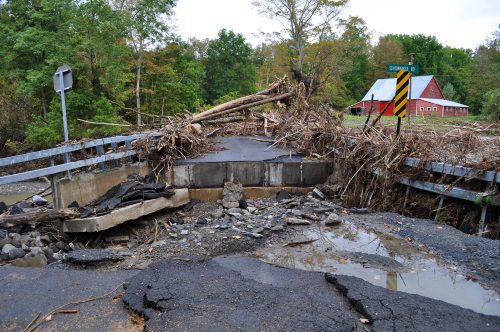Building Extreme Weather Resilience into Transportation Asset Management Programs

Six states are wrapping up Federal Highway Administration-sponsored projects examining weather resilience strategies for their highway infrastructure, with the agency expecting reports on their research to be filed sometime in February; reports FHWA then plans to publish in a resilience “guidebook” later this year.
[Above photo by Elissa Jun from the Federal Emergency Management Agency.]
That insight from Stephen Gaj, asset management team leader within FHWA’s office of infrastructure, jump-started a panel discussion on integrating “extreme weather resilience” into state transportation asset management plans or TAMPs; a panel held Jan. 16 at the 2019 Transportation Research Board’s annual meeting in Washington, D.C.

“This is an interesting topic as some states more than others deal with ‘extreme’ weather events such as wildfires, hurricanes, and others,” Gaj explained. “Most states have done a pretty good job evaluating extreme weather events. However, more work needs to be done to feed resilience data into the lifecycle planning side and investment strategy of their TAMPs. They need to come up with a network strategy.”
Elkins Green, director of the environmental division of the New Jersey Department of Transportation, stressed that understanding the “root cause” of extreme weather events is the key to developing effective lifecycle cost management for transportation assets. But he emphasized that those assets should not be viewed in “isolation” from one another.

“You need to see how they inter-relate and look at the transportation network impact as a whole,” Green explained. “You need to establish clear relationships between stressors, weather-related risks, and the impacts to the roadway.”
He added that data collection is a challenge as “gaps” in the collection of the reasons behind road closures does not result in a “true” indication of everything susceptible to flooding, for example.
“A GIS [geographic information systems] tool should be developed to assist in visualizing vulnerabilities and be incorporated in the life-cycle decision-making process,” Green said.
Elizabeth Habic, climate risk and resiliency program manager for the Maryland Department of Transportation, noted similar data “gaps” developed when her group evaluated 8,588 bridges for flooding.
“We looked at data collected from flood locations but found it sporadic,” she said. “We’re hoping to get a place in the future where we can get a clearer picture of where it floods, how often it floods, and damage it can cause.”

Jason Siwula, assistant chief engineer for innovation at the Kentucky Transportation Cabinet, noted that good asset management strategy is “about making quality decisions today that improve assets for tomorrow.” The key to that, he stressed, is properly weighted data that allows agency personnel to perform “hot spot” analysis.
“Data helps us develop a hierarchical approach of bridges, for example, that begins at the district level and then zooms down to individual structures,” Siwula said. “This lets agency personnel systemically identify regions and then structures that warrant further attention. It is hard to focus on the structures if we don’t have data.”
In early 2018, Kentucky suffered a major localized flooding event that led to 220 road and embankment failures. That’s why KYTC joined the FHWA’s resilience pilot project, he said; so agency personnel could learn about topography and climate vulnerabilities and develop a “composite bridge sensitivity index” to help evaluate bridges and culverts to determine those that could be “extra sensitive” to flooding.

Steven Olmsted, who works within the intermodal division of the Arizona Department of Transportation, noted his agency has been developing resiliency protocols for 10 years and is now trying to take the “next step” by creating a “regional screening opportunity” of transportation assets that may be vulnerable to extreme weather events.
[Editor’s note: Olmstead also presented a detailed presentation on this topic for TRB’s annual meeting three years ago.]
“All of this impacts financial decision-making; we’re already spending money fixing things, so you need to figure out a way to put in a compendium of information so you can develop resilience investment economic analysis,” he explained. “Eventually, we need to be able to figure out what the return on investment is for building more resilience into our transportation networks.”
Missouri’s Governor Puts $351M Worth of Bridge Spending in 2020 Budget
January 23, 2019


